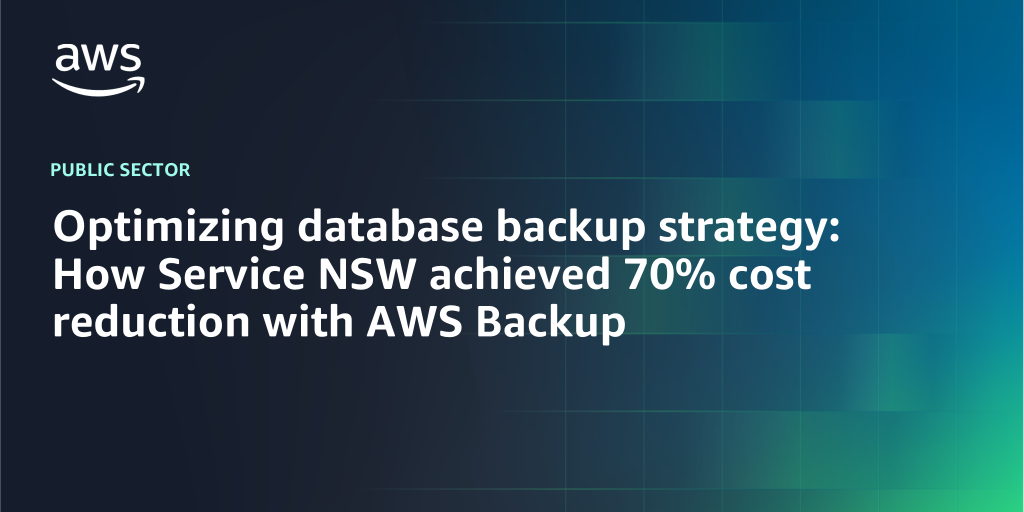AWS Public Sector Blog
Category: Amazon RDS
Optimizing database backup strategy: How Service NSW achieved 70% cost reduction with AWS Backup
In this post, we explore how Service NSW used AWS services to optimize its backup strategies while maintaining strict compliance requirements. By moving from a straightforward turnkey solution to a sophisticated, tiered approach, Service NSW achieved significant cost savings while enhancing its disaster recovery capabilities. The organization’s innovative use of automation for backup testing sets a new standard for efficient backup validation in large-scale database environments.
From local servers to global impact: How Learning Upgrade uses AWS to reach millions of learners in need
Learning Upgrade worked with AWS to modernize its platform and ultimately migrated fully to the cloud. This strategic shift empowered Learning Upgrade to scale globally, respond faster to new opportunities, and better serve learners in dynamic, resource-constrained environments. Read this post to learn more.
Modernizing mission-critical Oracle E-Business Suite on AWS: A success story in migration and optimization
In this blog, we discuss how government agencies can evaluate and implement AWS alternatives to traditional Oracle Real Application Clusters (RAC) deployments while maintaining mission-critical availability.
How CIMAR’s platform enables a national lung cancer screening program at scale, powered by AWS
In this post, we describe how AWS Partner CIMAR’s medical image management platform is enabling the rapid roll-out, scaling, and operation of the National Health Service (NHS) England’s national lung cancer program, connecting 124 acute NHS trusts and multiple mobile scanning units.
Near real-time dashboards from a source database to a cloud data warehouse on AWS
Organizations require solutions for real time or near real time dashboards that can be provided to their customers without impacting their database performance or service level agreements (SLAs) to their end users. In this post, we showcase the integration of Amazon Web Services (AWS) capabilities to present an end-to-end architecture for this data flow.
Benchmark Education accelerates grading and boosts student feedback with generative AI on AWS
Learn how Benchmark Education Company worked closely with Amazon Web Services (AWS) to build a grading tool powered by generative artificial intelligence (AI) to help teachers dramatically reduce the time they spend grading open-ended assessments—while maintaining accuracy, privacy, and trust.
Harnessing the power of generative AI in AWS GovCloud
In this post, we explore how generative artificial intelligence (AI), powered by services such as Amazon Bedrock and Amazon SageMaker, can be harnessed to meet the unique challenges of AWS GovCloud (US). We highlight use cases that demonstrate the potential of generative AI to enhance efficiency, automate workflows, and extract insights—all within a secure, compliant framework.
Transforming financial markets: How FIA Tech built the Trade Data Network on AWS
This post discusses how FIA Tech, a leading technology provider for the exchange traded derivatives (ETD) industry, built the Trade Data Network (TDN) on Amazon Web Services (AWS). TDN is an industry initiative that provides a shared ledger of trading information to address the fragmentation and lack of transparency in ETD post-trade processing. The TDN initiative currently includes 17 banks/brokers and 40 investment managers and hedge funds with combined assets under management of more than $34 trillion.
The Mercatus Center solves unstructured data challenges using generative AI from AWS
Seeking to make access to economic policy documents easier, the Mercatus Center — a university-based research center affiliated with George Mason University — created a generative artificial intelligence (AI) solution. Mercatus developed a platform, QuantGov, with assistance from Amazon Web Services (AWS) resources, including Amazon Bedrock, AWS Lambda, AWS API Gateway, and AWS RDS. Accessible through an interactive AI assistant, the platform provides scalable, accurate, and no-cost access to a treasure trove of data, helping policymakers craft informed public policy that will positively impact people’s lives.
How an open source EMR system has transformed patient healthcare in more than 50 countries
In countries where demand for healthcare outweighs available resources, and populations are spread out in remote locations, open source technologies using Amazon Web Services (AWS) can transform providers’ and patients’ experience. Bahmni, an open source electronic medical records (EMR) system is one that we have pioneered. It gives doctors rapid access to up-to-date health records and test results so that they have better information and more time for patient care. A system that started in a single hospital in a remote part of central India is now used by more than 500 hospitals in 50 countries.









